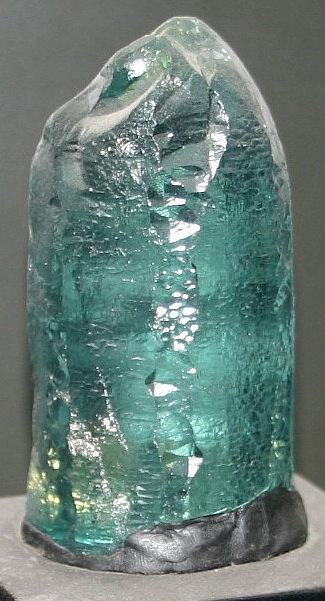Aquamarine
Aquamarine is a variety of beryl. Beryl minerals have the chemical formula Be3Al2(SiO3)6 - beryllium aluminium cyclosilicate; and the different colors of the different beryl varieties are caused by impurities of different mineral ions. [1] In the case of aquamarine, the color is caused by traces of iron. [2] Beryl varieties include aquamarine, maxixe, emerald, heliodor, goshenite, morganite and bixbite.

Aquamarine
Aquamarines can occur in a wide range of "sea colors" from pale to stronger sea blue. The name aquamarine literally means "sea-water", and is a reference to the blue-green color of the stone. It has had this name for a long time, and this derived from the French Aigue Marine. It was referenced in literature at least as early as 1598, when it was described as "One entire stone of a sea-water green colour, known by the name of the Agmarine". [3]
Aquamarine was also mentioned in Johann Gottfried Schmeisser's 1794 tome "A System of Mineralogy" - which described it as "a pale mountain green colour". He said that at that time aquamarine of fine color was being mined in Siberia. Schmeisser also noted that "when rubbed, it attacts light substances, as ashes, hairs and paper." [4]
Aquamarine Properties
Aquamarine, unlike emerald, sometimes occurs in the form of huge crystals: Perhaps the most notable of these was the 110.5 kg crystal found in 1910 in Marambaia / Minas Gerais, in Brazil. The largest aquamarine ever to have been cut was the "Dom Pedro", which weighed 26kg and was cut in 1992. [5] Aquamarine can also occur in glassy form, or with holes or unusual shapes.
Aquamarine is known for forming perfect, flawless gems; quite unlike emerald which is often flawed. Aquamarine is relatively hard, having a hardness of 7.5-8 on the Mohs scale.[2]
The leading producer of aquamarine is Brazil, but the mineral is also produced in the USA, Russia, Colombia, Pakistan, Madagascar, Mozambique, Afghanistan, Nigeria, Zambia and other places.
In folklore and legend, aquamarine, as one might expect, is considered a lucky stone for sailors. In tales of old it was once said to have originated in the treasure-chests of mermaids. It's also said to bring fortune in relationships and marriage. [5]
It is also possible to find asterism or chatoyance in aquamarine. [6]
Aquamarine - Sources Referenced:
[1] http://en.wikipedia.org/wiki/Aquamarine_(gemstone)
[2] http://www.galleries.com/minerals/gemstone/aquamari/aquamari.htm
[3] Oxford English Dictionary, 1971, "Aquamarine"
[4] http://books.google.com/books?id=-xo-AAAAcAAJ&pg=PA66
[5] http://www.gemstone.org/gem-by-gem/english/aquamarine.html
http://www.theimage.com/gemstone/beryl/beryl.html
Back to the Gemstones List home page - over 160 gemstones explored!
Please feel free to link to this page - copy / paste the text below: (click to select)
Privacy Policy | Cookie Policy | GDPR | About This Site / Terms

© gemstoneslist.com


